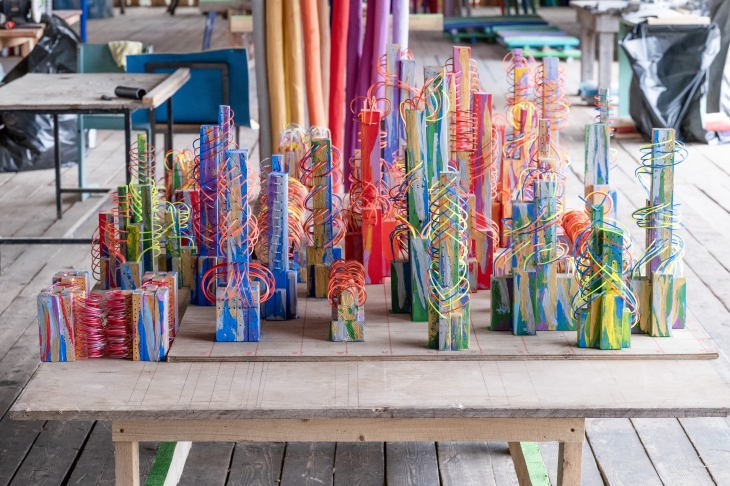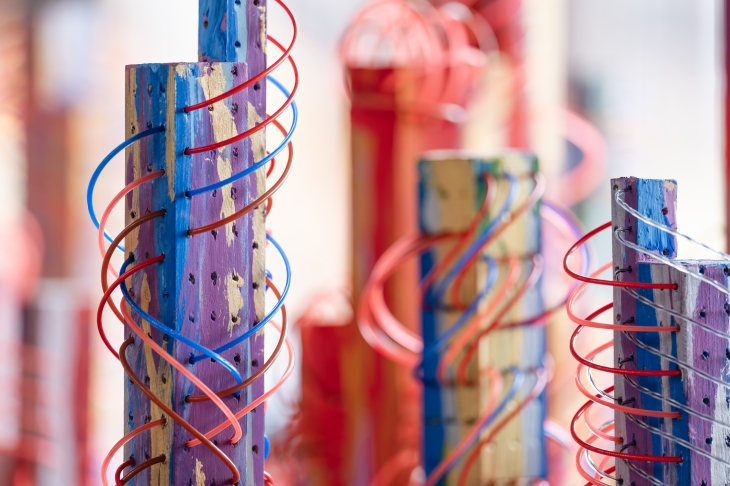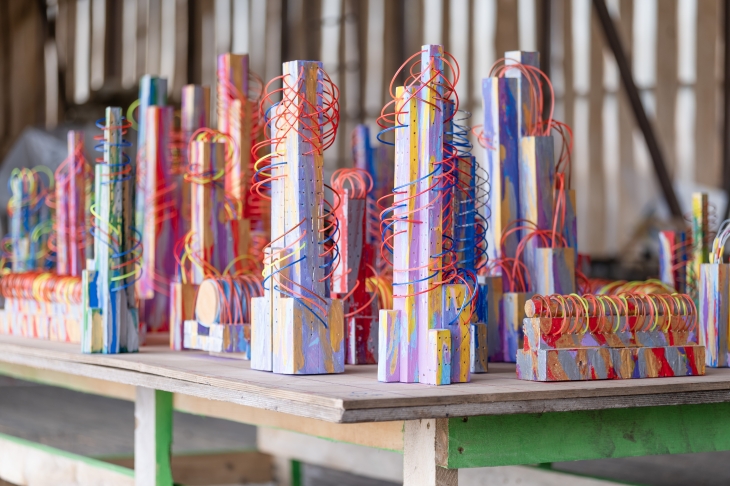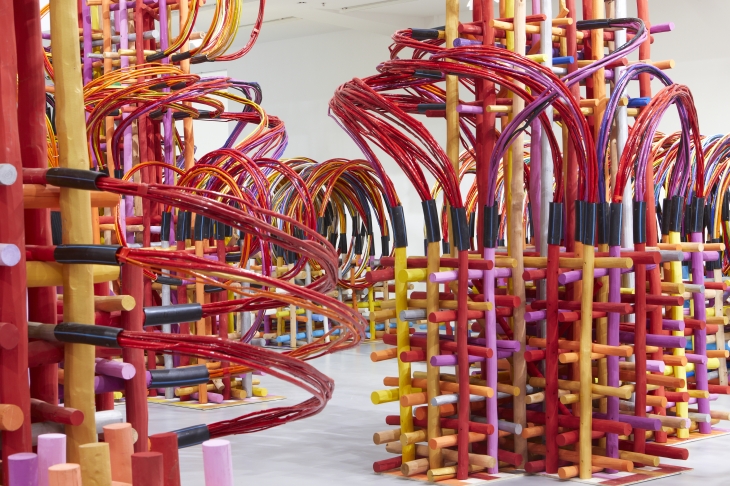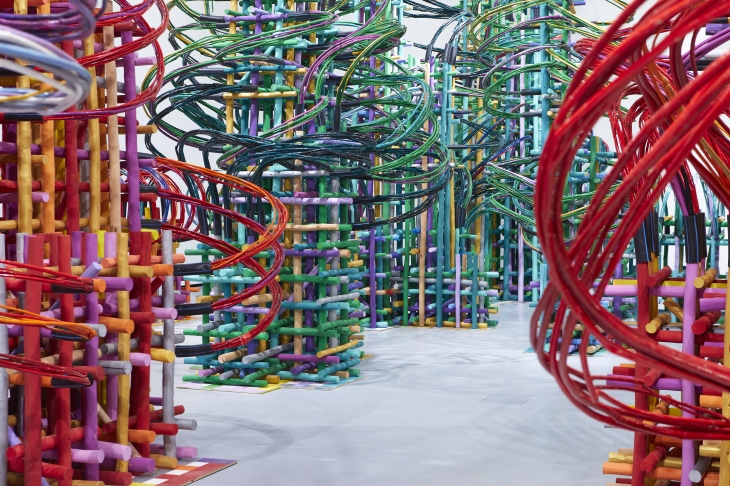For the press
Nikolay Polissky and the Nikola-Lenivets Crafts Artel
Electroart
Curator: Anna Zaitseva
The Multimedia Art Museum, Moscow presents the exhibition ‘Electroart’ by Nikolay Polissky, one of the most acclaimed Russian artists, the founder of Nikola-Lenivets, Europe’s largest art park, and Archstoyanie, the iconic festival of contemporary art and landscape objects.
Nikolay Polissky was born in 1957. He graduated from the Leningrad Higher School of Art and Design named after Vera Mukhina in 1982. In 1989 the artist settled in the Kaluga Region village of Nikola-Lenivets. Until 2000 he worked primarily as a painter. During a trip to Nizhny Novgorod in 2000 Nikolay Polissky had a vision: hundreds of snowmen standing on the high bank of the Ugra River, which flows past the village of Nikola-Lenivets.
Returning to the village in February, Nikolay Polissky, together with his friends Konstantin Batynkov and Sergey Lobanov, tried to build snowmen on the sloping riverbank, but the freezing temperature made this technically difficult. Then he spontaneously asked the villagers to help implement the project. Having left a diagram of the snowmen’s location in the village, the artist went back to the city. Two weeks later he received a call from Nikola-Lenivets, informing him that the ‘snow people’ were ready. The line of 250 snowmen, reminiscent of the Terracotta Army of the Chinese emperor from the Qin dynasty and also the Great Stand on the Ugra in 1480, was mesmerizingly beautiful. The artist photographed the snowmen before they melted in the spring sunshine. This project was a huge success with the art community, and MAMM acquired the photographs for its museum collection that same year.
Polissky himself believes that with the ‘Snowmen’ project he was reborn as an artist, at the age of 43. The picturesque landscapes around the village of Nikola-Lenivets became the main location for creating his art projects. For these he chooses only natural materials used in rural life (wood, vines, grass, vegetable seedlings etc.), and since 2000 he has worked with a group of craftsmen comprised of residents from the village of Nikola-Lenivets. The new social practice by which the workers’ artels became fully-fledged participants and co-authors of Polissky’s projects, their immersion in nature and its cycles, and the traditions of folk life became a powerful resource of creative energy for the artist, who customarily creates ephemeral objects that vanish in the bonfire during the traditional Maslenitsa celebration in Nikola-Lenivets, an event that today attracts thousands of spectators.
Critic Milena Orlova wrote: “Nikolay Polissky is often called a representative of land art, but this doesn’t really correspond to his concept. The material Polissky utilises is quite different – it’s not twigs and wood, but national Russian mythology and folk consciousness with faith in ingenuity, strength, and manual labour.” The artist’s works are connected with Russian mythology and the history of art, for example ‘Ziggurat’ from 2001, a huge haystack reminiscent of the Tower of Babel from the famous painting by Pieter Bruegel the Elder.
Since 2005 scientific and man-made objects have also become references for Nikolay Polissky’s projects. For example his project ‘Baikonur’, exhibited at the Tretyakov Gallery in 2005, ‘Large Hadron Collider’, created for the Museum of Modern Art in Luxembourg in 2009, or ‘Universal Mind’, constructed at Nikola-Lenivets in 2012.
Nikolay Polissky has worked on the project for MAMM for more than two years. ‘Electroart’ is a plastic metaphor of the modern metropolis, entangled with electric wires that reach underground and overground, penetrating residential and industrial spaces.
The 19th century brought several very important scientific discoveries that allowed us to understand the nature of electricity. In 1821 Michael Faraday demonstrated the principle of converting electrical energy into mechanical energy by means of an electromagnetic field. In 1876 Pavel Yablochkov received a patent for his invention of an electric lamp. Electricity began to be widely used for operating mechanisms, to provide lighting or heating, and also to transmit information. It literally infiltrated all spheres of life. Gadgets that have become an integral part of our lives cannot work without it. Vast databases cannot be stored on servers if there is no electricity. The 21st century is an era of incredible acceleration in the pace of scientific and technological progress. It is becoming increasingly difficult for human beings to understand the changes taking place.
For thousands of years people have comprehended the beauty of nature with the help of art. Today artists are trying to comprehend the technogenic world: we utilise its achievements but often fail to understand the mechanisms by which they function. “This world is incredibly complex for me, even overcomplicated,” says Polissky. “That’s why I’m trying to somehow make friends with it by doing a project of this kind.”
When creating ‘Electroart’ the artist appealed to the famous architectons of Malevich. The use of materials that are already traditional for Polissky, wood and vines, gives a certain warmth and humanity to universal archetypal forms.
Polissky actively works with colour in ‘Electroart’. The artist himself defines this phantasmagorical installation as a three-dimensional painting. Here he returns to his own experience as a painter, and also to the experience of the Impressionists who influenced him. For the artist, the strokes of pure local colour used by the Impressionists are like pixels that capture moments from an impression of reality. The pulsation of colour in Polissky’s project is both an attempt to visualise the passage of an electric current through the wires entangling the world, and a kind of cardiogram for the author’s emotional involvement during work on the project.
You can and should wander around Nikolay Polissky’s ‘city’, which resembles a forest thicket where it’s even interesting to lose your way. It returns our childhood ability to imagine and dream, and the childlike thirst for knowledge of the world in its entirety.

